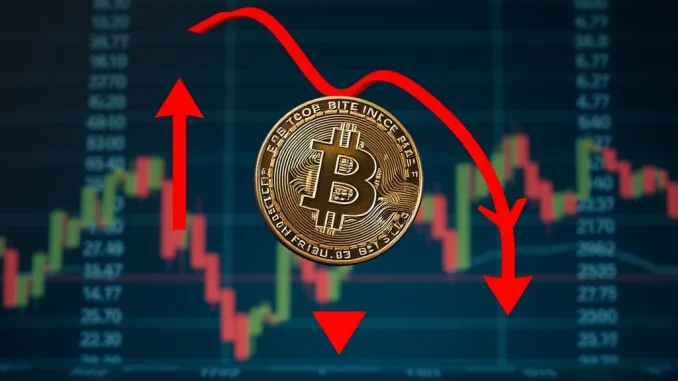
Breaking News: Bitcoin, the leading cryptocurrency, has experienced a sharp decline, breaching the $82,000 mark. According to real-time data from Coin Pulse market monitoring, BTC is currently trading at $81,986.97 on the Binance USDT market. This sudden dip has sent ripples across the crypto sphere, leaving investors and traders wondering what’s next. Is this a temporary setback or the start of a deeper correction? Let’s dive into the details and analyze what this Bitcoin price drop means for you.
Why is the Bitcoin Price Experiencing a Sudden Drop?
Market volatility is inherent in the cryptocurrency world, and Bitcoin price fluctuations are not uncommon. However, a significant drop like this often triggers questions and concerns. Several factors could be contributing to this recent downturn:
- Market Correction: After a period of sustained upward momentum, markets often undergo corrections. This is a natural process where prices retrace to find a new equilibrium. Profit-taking by investors who bought BTC at lower prices could be a key driver.
- External Economic Factors: Global economic events, regulatory announcements, or shifts in investor sentiment can significantly impact the crypto market. News related to inflation, interest rates, or government regulations can trigger sell-offs.
- Whale Activity: Large Bitcoin holders, often referred to as ‘whales,’ can influence market movements with substantial buy or sell orders. A large sell-off by a whale could exacerbate downward pressure on the BTC price.
- Technical Indicators: Traders and analysts often use technical indicators to predict market movements. If key indicators signaled a potential downturn, it could have led to preemptive selling, further pushing prices down.

BTC Price Analysis: Decoding the Current Market Sentiment
Currently, the BTC price hovering around $81,986.97 signifies a crucial juncture. To understand the potential trajectory, let’s consider a few key points:
| Metric | Current Value | Significance |
|---|---|---|
| Current Price | $81,986.97 | Breaching the $82,000 support level. |
| 24-Hour Trading Volume | Increased | Potentially indicates higher selling pressure and market activity. |
| Fear & Greed Index | Likely Decreased | Reflects increased market anxiety and uncertainty. |
| Support Levels | Next major support around $80,000 | A break below this could lead to further declines. |
Analyzing these metrics provides a snapshot of the current market sentiment. The increased trading volume coupled with a price drop suggests heightened selling activity. Monitoring the Fear & Greed Index can offer insights into the overall market psychology – a move towards ‘fear’ often accompanies price corrections.
Navigating the Crypto Market Dip: Strategies for Investors
When the crypto market experiences a dip, it can be unsettling, but it also presents potential opportunities. Here are some strategies to consider:
- Stay Calm and Avoid Panic Selling: Market corrections are a normal part of the crypto cycle. Emotional decisions can often lead to losses. Assess your risk tolerance and investment strategy before making any rash moves.
- Dollar-Cost Averaging (DCA): Consider DCA, which involves investing a fixed amount of money at regular intervals, regardless of the price. This strategy can help mitigate risk during volatile periods.
- ‘Buy the Dip’ (Carefully): For investors with a long-term perspective and strong conviction in Bitcoin, a price dip can be seen as a buying opportunity. However, conduct thorough research and only invest what you can afford to lose.
- Review Your Portfolio: Downturns are a good time to re-evaluate your portfolio. Are your holdings aligned with your risk tolerance and investment goals? Consider rebalancing if necessary.
- Stay Informed: Keep up-to-date with Bitcoin news and market analysis from reputable sources. Understanding the underlying factors driving market movements can help you make informed decisions.
Latest Bitcoin News and Future Outlook
Keeping abreast of the latest Bitcoin news is crucial in navigating market volatility. Recent developments, regulatory updates, technological advancements, and macroeconomic trends can all influence Bitcoin’s price trajectory. While predicting the future is impossible, considering various factors can help form a reasonable outlook.
Currently, market analysts are closely watching for signs of stabilization and potential rebound. The $80,000 level is being observed as a critical support. A bounce back from this level could indicate renewed buying interest, while a further drop could signal a deeper correction. The long-term outlook for Bitcoin remains a subject of ongoing debate and analysis, with proponents citing its scarcity and growing adoption, while critics point to its volatility and regulatory uncertainties.
Understanding Cryptocurrency Dip and Volatility: Embracing the Nature of the Beast
The recent cryptocurrency dip serves as a stark reminder of the inherent volatility in this asset class. Volatility is not necessarily a negative aspect; it presents both risks and opportunities. Understanding and accepting volatility is key to successful crypto investing.
Key Takeaways about Cryptocurrency Volatility:
- It’s Normal: Price swings are a characteristic feature of cryptocurrencies, especially compared to traditional assets.
- Driven by Multiple Factors: Volatility is influenced by market sentiment, news events, technological developments, regulatory actions, and more.
- Opportunity and Risk: Volatility creates opportunities for traders and investors but also carries significant risk.
- Risk Management is Crucial: Proper risk management strategies, like diversification and position sizing, are essential in navigating volatile markets.
In Conclusion: Navigating the Bitcoin Price Fluctuations
The Bitcoin price falling below $82,000 is a significant event that demands attention from crypto enthusiasts and investors. While the immediate cause may be multifaceted, it underscores the volatile nature of the cryptocurrency market. By staying informed, understanding market dynamics, and employing sound investment strategies, you can navigate these fluctuations and potentially capitalize on opportunities that arise. Remember to conduct your own research, assess your risk tolerance, and invest responsibly. The crypto journey is often a rollercoaster, and understanding the dips is just as important as celebrating the peaks.



